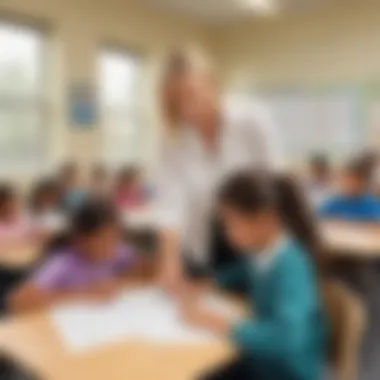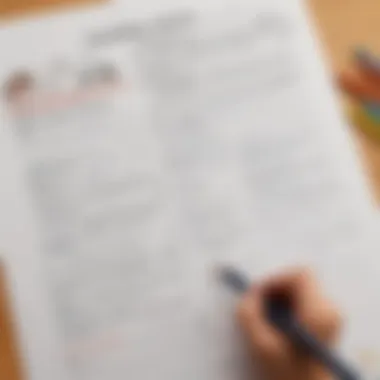Understanding Spelling Worksheets: Essential Educational Tools


Intro
Spelling is a foundational skill in literacy, particularly for elementary school children. Mastery of spelling not only improves reading abilities but also enhances writing and communication skills. Educators and parents often seek effective methods to enhance a child's spelling knowledge. This brings us to spelling worksheets, a resource utilized widely in classrooms and homes.
The ability to spell correctly plays a crucial role in how children convey their thoughts and ideas. Spelling worksheets can be tailored to meet diverse learning styles, making them effective tools for enhancing young learners' literacy skills. In this guide, we will cover the significance of these worksheets, the various types available, their effective design and usage, along with the integration of interactive elements that make learning more engaging and effective.
Creative Activities
Incorporating creative activities into spelling worksheets adds depth and fun to the learning process. Children often engage more with material that allows them to express themselves and use their imagination.
Craft Ideas
Here are some craft ideas that children can replicate easily:
- Word Collages: Children can cut letters out from magazines and arrange them to form their spellings.
- Spelling Bingo: Create a bingo card filled with spellings. Kids can mark a word when it's called out.
- Story Cubes: Create cubes with different letters on each side. Kids can roll them to come up with new words.
Step-by-Step Guides
Implementing these crafts involves simple steps:
- Gather materials like paper, scissors, glue, and color pens.
- For word collages, cut the letters out carefully.
- For spelling bingo, prepare a blank grid and fill it with words, then play with multiple children for added fun.
Educational Value
Engaging in these activities offers children a chance to reinforce spelling in a tangible way. The process of creating keeps their minds active and helps in better retention of spelling rules.
Fun Quizzes
Quizzes are another engaging medium for reinforcing spelling skills. Interactive quizzes can motivate children while providing substantial learning benefits.
Quiz Topics
Some topics that could be covered in spelling quizzes include:
- Homophones
- Commonly misspelled words
- Vocabulary words from recent lessons
Question Types
The variety of question types used to engage children can include:
- Multiple-choice questions
- Fill in the blanks
- Match the word to its meaning
- Unscrambling words
Knowledge Reinforcement
These quizzes help reinforce learning by repeatedly exposing students to spelling. Active recall during quizzes supports memory, making it easier for children to remember the spellings in the future.
Fact-Based Articles
Fact-based articles enhance the child’s understanding of language rules and expose them to rich vocabulary when reading. Each article can significantly enhance literacy and engagement.
Topics
The range of topics covered in these articles is wide, such as:
- The history of language
- Interesting facts about words, like origin and usage
- Word families and how they function in sentences


Engaging Content
Articles are written in a way that is easy to understand. They present information logically, often accompanied by fun examples to maintain interest.
Foreword to Spelling Worksheets
Spelling worksheets serve as a vital component in the educational journey of elementary students. They are designed not just for rote memorization of words, but also facilitate a deeper understanding of the English language's structure and usage. The effectiveness of these tools can greatly influence a child's literacy skills, making them a subject worth discussing in detail.
Definition and Purpose
Spelling worksheets refer to printed or digital documents that aim to help students learn how to spell words correctly. These worksheets typically include various activities such as fill-in-the-blank, matching exercises, and word puzzles. The purpose is to reinforce spelling skills while encouraging comprehension. Activities may also teach students about word origins and the context in which certain words are used. This comprehensive approach goes beyond mere memorization, aiming to foster a love for words and the understanding of language nuances.
Importance in Elementary Education
The significance of spelling worksheets cannot be understated. They play a critical role in elementary education for the following reasons:
- Foundation for Literacy: A strong grasp of spelling contributes to improved reading and writing skills. Worksheets promote practice that aids in recognizing words as students progress in learning.
- Cognitive Development: Engaging with spelling worksheets enhances linguistic skills. It strengthens students’ memory and cognitive abilities by helping them to categorize and recall words.
- Personalized Learning: Worksheets allow for adaptability, as educators can tailor the content based on a child's unique learning pace and style.
Nevertheless, the challenge lies in engagement levels. Teachers must actively seek innovative methods to ensure that the worksheets remain interesting and stimulating for young learners. Like any educational tool, spelling worksheets come with both advantages and challenges, but their foundational role in shaping language abilities remains undeniable.
Types of Spelling Worksheets
Spelling worksheets serve as vital educational tools in any elementary language curriculum. They come in various forms, each offering a unique approach to teaching and learning. By selecting the right type of worksheet, educators and caregivers can tailor instruction to the needs of the students. The different types of worksheets include traditional worksheets, interactive worksheets, and digital spelling worksheets. Each type has particular benefits, considerations, and applications in a classroom setting.
Traditional Worksheets
Traditional spelling worksheets are the most familiar among educators and parents. They often feature simple layouts that focus on specific spelling words and exercises. In a typical setup, students may find sections dedicated to writing words multiple times, filling in missing letters, or completing sentences with appropriate vocabulary. The emphasis is usually on rote memorization and written exercises, focusing primarily on core skills that reinforce spelling rules.
These worksheets help in building a strong foundation in spelling. They allow students to practice their writing and familiarize themselves with word patterns. However, they can sometimes lack engagement, making it necessary for educators to balance worksheet tasks with more interactive activities.
Interactive Worksheets
Interactive worksheets represent a more engaging approach to spelling. This type encourages active involvement from students. An example might be incorporating puzzles, games, or matching exercises that stimulate learning through fun activities. This variety allows for deeper engagement, encouraging children to think critically about word usage in different contexts.
Furthermore, the interactive element is crucial for maintaining student interest. This method can effectively cater to various learning styles, enhancing participation quotient. In classrooms, using interactive worksheets often results in focused learning environments where students are motivated to partake actively.
Digital Spelling Worksheets
The emergence of technology transforms education significantly, and spelling worksheets are not exception. Digital spelling worksheets employ platforms or apps that create a dynamic learning experience. Students can engage with spelling through multimedia presentations, online games, or interactive quizzes.
The main advantages of digital worksheets are accessibility and adaptability. Students can complete their assignments at any time or place with internet connectivity, making it easier for those who need additional flexibility. Also, teachers can track students' progress instantly and analyze performance effectively, allowing for timely intervention when necessary.
Research suggests that digital solutions promote longer retention of language skills over traditional methods.
In summary, the diverse types of spelling worksheets greatly contribute to an adaptable learning experience. Educators and caregivers should explore all available options to find the right balance between the three types discussed: traditional, interactive, and digital. Each type can cater to differing student needs while enhancing literacy skills overall.
Creating Effective Spelling Worksheets
Creating effective spelling worksheets is crucial for fostering literacy in young students. These worksheets serve not just as a method of practice but also as tools for comprehension and engagement. The organization of content, relevance of vocabulary, and the integration of visuals all play vital roles in how pupils interact with their learning material. When designed well, these worksheets can significantly enhance the learning experience, making the task of mastering spelling both enjoyable and enriching.
Designing Layouts
The layout of a spelling worksheet deeply influences a child’s ability to engage with the material. A cluttered or overly complex design can lead to frustration and confusion. Instead, simplicity should be prioritized. Clearly defined sections, ample white space, and consistent formatting help children focus on the task. Further, it’s beneficial to use different fonts or bold headings to denote changes in activity. For instance:
- Word Lists: A visually designated space for spelling lists helps students know where to look.
- Activities: Segregating practice activities with medium lines or bullet points can reduce cognitive load.
Combining visually stimulating and straightforward designs will no doubt increase student engagement and allow for a better understanding of the material.


Choosing Appropriate Vocabulary
Selecting the right vocabulary is an essential aspect of creating effective spelling worksheets. The words chosen should align with the students' level and their current curriculum. Consideration must be given to frequently used words that children will encounter in their reading and writing. This affords them practical spelling opportunities. Moreover, including a mix of sight words and phonics-based words ensures that all dimensions of literacy are addressed. Here are a few pointers for selecting vocabulary:
- Aim for age-appropriate words.
- Involve thematic or subject-specific terms for context-rich learning.
- Blend familiar words with challenging ones to encourage growth.
Adequately chosen vocabulary not only aids spelling mastery but also strengthens reading comprehension.
Incorporating Visual Aids
Visual aids can significantly boost a child’s understanding and retention of spelling. When children associate words with relevant images, it enhances memory and facilitates learning. Effective use of visuals can range from including pictures of objects to illustrating word meanings through simple drawings. This adds a multi-sensory element to spell learning, making it more appealing to young minds. To integrate visuals successfully, consider:
- Images: Include effective and related images beside vocabulary words.
- Color: Utilize brightly colored sections to draw attention to particular words or activities.
- Interactive Elements: Encourage drawing or cutting out pictures related to vocabulary.
Using these strategies will help create a dynamic educational experience, enabling children to connect with the spelling words more meaningfully.
“Effective spelling worksheets require thoughtful design, appropriate words, and essential visual aids.”
Implementing Spelling Worksheets in the Classroom
Implementing spelling worksheets in the classroom is a vital part of the educational process. Teachers can effectively cultivate literacy skills by integrating these resources into the lesson plans. The use of spelling worksheets engages students and supports their understanding of word structures. Worksheets also create a structured environment for learning, giving students clarity in their tasks. Furthermore, these worksheets offer a standardized way to assess students’ progress, giving educators a varied understanding of individual capabilities.
Effective Teaching Strategies
Developing effective teaching strategies when using spelling worksheets presents various options for engagement. A mixed approach usually works better. Here are some strategies:
- Group Activities: Involve students in group work. This encourages them to collaborate on spelling tasks, allowing for shared knowledge and support. Students can learn from each other in these settings.
- Explicit Instruction: Small lessons on specific phonics concepts that connect to the worksheets' content can enhance understanding. This type of direct teaching is beneficial.
- Differentiated Learning: Tailor worksheets to meet different learning levels within the classroom. For example, advanced learners might get more complex words, while those needing more support might focus on basic terms. Adjusting for differences ensures every student can engage meaningfully with content.
- Interactive Techniques: Use technology where possible. Encouraging the use of interactive worksheets promote much higher engagement. Tools like Google Classroom provide avenues for students to practice.
Assessing Student Progress
Assessment plays a crucial part in understanding how effective spelling worksheets are in the classroom. Monitoring students requires some considerations, as informal assessments can provide key insights. Here’s how to effectively assess your students:
- Regular Quizzes: Short, informal quizzes can help gauge understanding of the material covered in spelling. These can drive focus on continual improvement.
- Portfolio Creation: Keeping a portfolio of completed worksheets allows a tangible view of a student's progress. This approach makes it easier to track development over time.
- Feedback Sessions: Held separately from routine assessments, feedback sessions contribute greatly. Speaking individually to students helps understand their experiences and difficulties, and allows for personal encouragement and modification of care if needs arise.
Building literacy relies heavily on consistent engagement. Assess restful~ ensuring that lasting skills are developed.
Incorporating spelling worksheets in the classroom blends creativity with assessment. It offers diverse pathways to delve deep into the learning experience. When executed thoughtfully, it leads not only to greater spelling capabilities, but to enhanced overall literacy skills among young learners.
Advantages of Spelling Worksheets
Spelling worksheets are pivotal tools in the landscape of elementary education. They offer numerous benefits, providing both structure and support for young learners. Understanding these advantages can help educators and caregivers in selecting the best methods to enhance literacy and encourage effective learning.
Enhancing Literacy Skills
One primary advantage of spelling worksheets is their role in enhancing literacy skills. Objectively, literacy includes not just the ability to read and write but also the understanding of words and their applications.
Worksheets can reinforce spelling through repetitive practice. When students repeatedly engage with the material, they are more likely to internalize the words and their correct spellings. This practice helps build a strong vocabulary base, which is critical for reading comprehension. Furthermore, through targeted exercises such as fill-in-the-blank or matching words with images, children can connect words with their meanings, thus deepening their understanding.
Additionally, academic research shows that students with strong spelling skills tend to excel in other areas of language arts. Encouraging consistent spelling practice narrows gaps in learning and hones children’s abilities to recognize patterns in language, further enhancing overall literacy.
Promoting Independent Learning
Another significant benefit is promoting independent learning. Spelling worksheets encourage students to take ownership of their education. By engaging with these worksheets independently, children learn self-management skills important for lifelong learning. They can work at their own pace, revisiting challenging words or challenges until they feel confident.
One way to enhance this aspect is through immediate feedback. For instance, worksheets can include answer keys or be graded promptly. Online spelling worksheets, which often come with interactive features, can also facilitate this. The structure of using worksheets nurtures an environment where students feel safe to explore and make mistakes. They can also develop strategies for problem solving, critical thinking, and organization—all essential skills that extend beyond just spelling.


Challenges in Using Spelling Worksheets
Using spelling worksheets comes with its own set of challenges. While they offer numerous benefits, it is important to recognize the hurdles that educators, parents, and even children face during the learning process. Acknowledging these challenges fosters a more constructive approach to effective spelling education. Understanding issues like differentiating instruction and maintaining engagement levels can lead to improved outcomes and a better learning environment for students.
Differentiating Instruction
One challenge in using spelling worksheets is differentiating instruction. Not all students progress at the same pace or level in spelling proficiency. It is crucial for educators to tailor the content to suit individual needs. This may involve creating multiple versions of a spelling worksheet with varying levels of difficulty, so that all learners can have a chance to succeed.
Considerations:
- Assess individual abilities - Regularly evaluate a student’s skills to choose the right opening point. This can involve easy or hard words depending on the child's current grasp on spelling.
- Utilize group activities - Create opportunities for students to work in small groups, where they can help each other, catering to diverse abilities while promoting collaboration in learning.
- Immediate feedback - Offer timely reviews of completed worksheets. This can help adjust future expectations based on the learnings from each assignment.
Engagement Levels
Another significant challenge is maintaining engagement levels among young learners. Spelling worksheets may become monotonous if they lack variety and dynamism. When students find the task too similar or uninteresting, their motivation can decline, affecting their learning experience. Efforts to increase engagement can sometimes be overlooked in the process of implementing these worksheets.
Strategies to Improve Engagement:
- Incorporate interactive elements - Integrating interactive components, like covering anti issues or pairing with computing activities, can make worksheets more lively.
- Apply real-world contexts - Using vocabulary that relates to students' lives or current events can capture their interest more effectively.
- Reward progress - Establishing a recognition system for achieving spelling milestones can make the learning experience rewarding and enjoyable. Digital platforms and gamified learning can support these efforts.
"Differentiate to elevate – Without differentiated worksheets or engaging material, students' progress may stall."
Recognizing these challenges ensures more fruitful outcomes when using spelling worksheets. With appropriate adjustments and strategies in place, both teachers and students can derive the maximum benefits while navigating potential downsides effectively.
Future of Spelling Worksheets
Understanding the evolving role of spelling worksheets is critical in today's education. The future of these tools is influenced by advancing technology, changing pedagogical strategies, and the diverse needs of modern learners. As more educational technology emerges, the incorporation of various interactive elements will likely play an increasingly important part in promoting engagement and effectiveness.
Trends in Educational Technology
Currently, educational technology is reshaping how spelling worksheets are created and used. Key trends include:
- Adaptive Learning Tools: These are programs that adjust to individual student needs, helping them master spelling at their own pace.
- Gamification: Integrating game-like elements into worksheets can significantly increase student involvement, making the learning process more enjoyable.
- AI Support: Artificial intelligence can analyze students' spelling patterns and difficulties, offering tailored exercises to enhance learning.
An example of such a tool is the app “Spelling Stage,” which allows students to practice their spelling through fun quizzes and score achievements, thus drive motivation.
"Incorporating educational technology not only supports spelling acquisition but also respects individual learning preferences."
Potential Developments in Design
In the upcoming years, the design of spelling worksheets is expected to evolve in several impactful ways:
- User-Centric Interfaces: Designs that cater specifically to the user experience will enable faster learning. Worksheets will become more intuitive, reducing cognitive load on students.
- Multisensory Approaches: Integrating visuals, tactile components, and digital media can cater to varied learning styles. This allows all students, including those with learning disabilities, to benefit from spelling instruction.
- Interactive PDFs: Worksheets will likely transition into interactive formats, linking various resources directly within each page. This connectivity allows students to explore related concepts while working on spelling.
Closure
In the realm of education, drawing conclusions about subjects empowers both teachers and students. This article focused on spelling worksheets, illustrating their significance in fostering literacy skills among elementary school learners. Spelling worksheets are more than mere tasks; they serve as foundational tools that guide young minds toward effective communication. They deliver key benefits, invoking structure in learning, enhancing vocabulary acquisition, and encouraging independent study habits.
Summary of Key Points
To wrap up, we can glean several important points from our exploration of spelling worksheets. These include:
- Diverse Formats: Spelling worksheets come in traditional, interactive, and digital formats, each catering to different learning styles.
- Effective Design: Incorporating visual aids and understandable layouts tailors comprehension for young learning levels.
- Teacher Strategies: Methods to implement worksheets meaningfully ensure they reinforce knowledge rather than create disinterest among students.
- Productivity in Learning: Worksheets promote literacy while acknowledge diverse ability ranges, needing careful consideration in implementation.
- Future Trends: The advancement of educational technology hints at an evolving landscape for spelling practice, making it more engaging and effective for students.
Final Thoughts on Spelling Education
The usage of spelling worksheets is an enlightening aspect of education that additionally mirrors the evolution of teaching techniques. While challenges exist, like different student needs and the engagement factor, meaningful implementation addresses them. Educators and parents are encouraged to insert creativity into worksheet tasks while ensuring core spelling values are present.
Reflecting on future possibilities, the integration of technological elements into spelling education may foster deeper connections among students with the material. As platforms advance, the emphasis remains on nostalgic principles of language acquisition while promoting intrigue in learning. Educators and students alike should embrace this again frame of teaching and workflows, for in understanding comes opportunity for success.
“Great teaching not only imparts knowledge but inspires students to pursue it.”
In summarizing the narrative, it is clear to see that spelling worksheets have a pivotal role in shaping successful future communicators.







